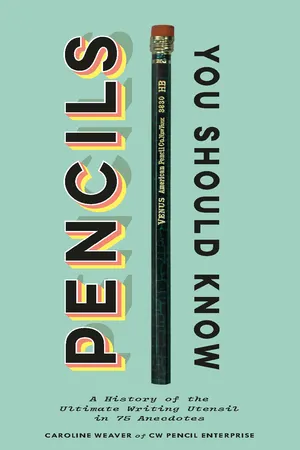![]()
The Pencils
![]()
Lead Pencils
1830s — John Thoreau & Co. — Concord, Massachusetts, USA
John Thoreau was the first commercially successful pencil maker in American history. He started crafting pencils by hand in Concord, Massachusetts, in the 1810s, with the help of his son Henry David, who would later become a famous writer. Early Thoreau pencils were made with a combination of graphite, glue, bayberry wax, and spermaceti. They were cased in cedar by hand and sanded until round. Thoreau’s pencils were rustic in appearance—unfinished, simply branded, and sold in bundles of twelve. Legend says that it was Henry David who came up with the idea to make pencils of different grades, numbered 1 through 4, from dark/soft to light/firm, just as we’re used to grading them today.
![]()
Star No. 2 Pencil
1881 — A.W. Faber — New York City, New York, USA
In the 1600s, German cabinetmaker Kaspar Faber founded global pencil giant A.W. Faber, now known as Faber-Castell. The Faber family has played a major role in pencil history for the past four centuries, making pencils in many countries and under several brand names. In the 1800s the Fabers set up a subsidiary in New York to take advantage of a new market and the plentiful resources of the United States. One of the pencil models they made in their new Manhattan factory was the Star, stained in three different finishes. Star pencils are unusual in that they are printed with the date of their trademark registration. At this point, pencils were still largely made by hand, which is evident in the square shape of the lead, which would have been cut from pure graphite and cased in manually.
![]()
No. 123 HB Pencil
1940s — Cumberland Pencil Company — Cumbria, England
The first graphite was discovered in England’s Lake District in the 1560s when a tree was uprooted during a storm, its roots covered in a strange black substance resembling lead. At the time, not enough was known about the chemistry to identify the substance’s unique properties and give it an appropriate name. For many years it was referred to simply as “black lead.” (This is why we still often call graphite “lead,” although the core of a pencil has actually never contained lead at all.) The site of this discovery was converted into a graphite mine; it is no longer in operation, yet to this day it is known as the source of the purest graphite ever discovered. Some of the earliest wood-cased pencils were made by the local Cumberland Pencil Company, now known as Derwent Cumberland Pencil Company. Though this example is from the 1940s, they were made in the style of the very simple, handmade pencils of the 1800s.
![]()
American Graphite Pencil
Late 1800s — Joseph Dixon Crucible Company — Jersey City, New Jersey, USA
Joseph Dixon was a well-known nineteenth-century inventor and industrialist. His accomplishments, which include developing camera technology, inventing the double-crank steam engine, and devising a method for printing banknotes, span many industries. He was the first in the United States to use graphite for practical purposes—most notably for making crucibles, his main business in his New Jersey factory—though his real passion was making pencils, a skill that he painstakingly tried to perfect for decades. Dixon was also among the first to take advantage of the progress of the industrial revolution to mechanize the craft, and toward the end of his life he finally started making a profit on his wood-cased masterpieces. This is an example of an early Dixon pencil, with a little crucible logo on it. The Dixon name is now mostly associated with the Ticonderoga, a pencil made after Joseph Dixon’s death—and that has become an American classic.
![]()
Crayon 6626 Pencils
Late 1800s — Eberhard Faber Pencil Company — New York City, New York, USA
John Eberhard Faber, a member of the famous Faber family, moved to New York in the late 1800s to run the U.S. branch of the family business. He soon decided to go it alone, however, and started his own competitive brand of American-made pencils. This bundle is from the late 1800s, wrapped in a style that was very common in the nineteenth century before boxes became the fashion. Operating out of New York City, Eberhard Faber and his descendants are responsible for some of the most iconic American pencils ever made. Ironically, they were eventually acquired by none other than Faber-Castell—the parent company that Eberhard Faber originally abandoned.
![]()
Crayon Velours Pencil
Early 1800s — Conté — Paris, France
This abnormally long, beautifully ornate French pencil came from the early 1800s, when th...






